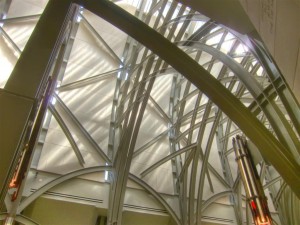Using GFRC to Manage Your Acoustics
Acoustics in Architecture
Acoustics are important in architecture. No one wants to live in a noisy home or shop in a noisy store. Focusing on noise reduction is especially important when the building in question is near a noisy freeway, playground, or other noisy venue. Acoustics management allows audiences to hear a performance clearly while minimizing the noise of other audience members. Stromberg Architectural Products offers a variety of attractive, GFRC-based solutions for managing acoustics in spaces large and small.
Using GFRC to Manage Your Acoustics
In order to manage your acoustics, it is important to understand some of the properties of sound. Sound travels in waves through air and many surfaces. The two important measures of sound are its amplitude and its frequency.
Amplitude is how loud a sound is. Amplitude is measured in decibels. A rural area at night has an ambient noise of about 10 decibels. A rock concert is about 120 decibels. This is about the threshold of feeling the noise. It also will damage hearing if experienced for a long period of time.
The other measure of sound is frequency. Frequency is familiar to most people as the number on the dial of their favorite radio station. Lower frequency noises travel further in the atmosphere than higher frequency noises. This is why the base on your neighbor’s radio is so annoyingly loud while you cannot hear the treble part of his station.
Mitigating Noise
Sound can be absorbed and the noise in a building lowered in three ways:
- Porous absorption uses porous substances such as shag carpet or glass fiber. The sound energy causes the fibers to move slightly, using up the sound energy before it travels to the person. This is why some practice halls have carpet on the walls.
- Panel absorption involves installing several lightweight panels with air voids between them. The sound waves cause the panels to vibrate and use up the energy of the sound that way. This works best when the panels are matched to the frequency of the sound.
- Cavity absorption uses a bottle neck to cause friction and convert the sound wave energy to heat. For example, the slotted concrete masonry unit, where the sound waves rub against the concrete as they travel through the slot.
Of course, sometimes you want sound waves to travel. One of the reasons Carnegie Hall is renowned is because of the wonderful acoustics there. To enhance the acoustics, the surface should be hard, nonporous, and reflect rather than absorb sound waves. Actually, concert halls need two kinds of surfaces. The stage area should be hard and reflective, while the area in which the audience sits should absorb their ambient noise. Getting the sound reflection versus absorption rates of the various surfaces right is a difficult task. Stromberg GFRC can assist you in doing that by casting GFRC with sound absorbing or sound reflecting surfaces.
Features and Benefits of Stromberg Glass Fiber Reinforced Concrete
- available in many different designs
- available in many textures, colors, and finishes
- nontoxic and fire resistant
- relatively lightweight
- able to be customized to suit your needs
- able be cast with light features in the item
GFRC Acoustic Management Venue Suggestions
- Churches — reflect the sermon and choir into the congregation, muffle congregation noise during the service, reduce noise from outside coming into sanctuary
- Concert Halls — send sound soaring into the rafters so even the cheap seats can hear every word
- Schools — muffle hall noise and the clanging of lockers
Specific Applications of GFRC In Acoustics Management
- Can be cast to absorb sound and mute outside distractions
- Can be case with a pitted and textured surface to provide superior acoustics when desired
- Both surfaces can be combined in one building to provide superior performance experiences
For More Information on Stromberg GFRC
Professionals at Stromberg Architectural Products are waiting to assist you with your Glass Fiber Reinforced Concrete (GFRC) project. Stromberg offers design assistance, CAD details, and specifications. Visit Stromberg Architectural Products for more information about landmarks in quality GFRC, or call (903) 454-0904. Stromberg is here to help, and the initial consultation is free.



October 21, 2011
GFRC Information